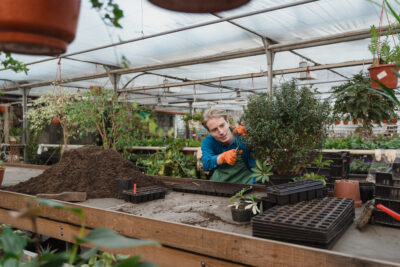
Do Succulent Roots Penetrate Deep into the Soil?

Succulents are known for their ability to store water in their leaves and stems, making them highly adaptable to arid environments. However, there is a common misconception that succulents have deep roots that can reach deep into the soil to access water. We will explore the truth behind this belief and examine the root structure of succulents.
We will delve into the root systems of succulents and discuss whether or not they have deep roots. We will explore the different types of succulents and their unique root structures, as well as the factors that influence the depth of their roots. Additionally, we will examine the importance of understanding the root system of succulents for their care and maintenance. By the end of this article, you will have a better understanding of how succulent roots function and how to properly care for these fascinating plants.
- Succulent roots do not typically penetrate deep into the soil
- They have shallow root systems
- This is because succulents are adapted to arid environments
- Shallow roots allow them to quickly absorb water when it rains
- Succulents can survive with limited access to water
- Their shallow roots also help them avoid waterlogged soil
- Succulent roots spread out horizontally near the soil surface
- They may develop a fibrous root system
- Some succulents may develop taproots, but they are still relatively shallow
- Overall, succulent roots are not known for their depth
Succulent roots do not typically penetrate deep into the soil
Succulent plants, known for their ability to store water in their leaves and stems, have unique root systems that differ from other plant species. Unlike many plants that develop deep root systems to access water and nutrients from the soil, succulents typically have shallow root systems.
These shallow roots allow succulents to quickly absorb water when it rains or when they are watered. The roots spread out horizontally rather than digging deep into the soil. This adaptation enables succulents to capture as much water as possible before it evaporates or drains away.
Furthermore, succulent roots are often concentrated near the surface of the soil, where they can easily access sunlight for photosynthesis. The shallow root system also aids in stabilizing the plant and preventing it from toppling over, especially in windy conditions.
Advantages of shallow succulent roots
The shallow root systems of succulents offer several advantages. First and foremost, they allow these plants to thrive in arid environments with limited water availability. By spreading their roots near the surface, succulents can quickly absorb any rainfall or irrigation water that reaches the soil.
 Avoid Overwatering: Tips for Healthy Succulents
Avoid Overwatering: Tips for Healthy SucculentsAdditionally, shallow roots reduce the risk of root rot, a common problem in plants that are overwatered or exposed to excessively moist soil. With their water storage capabilities and shallow roots, succulents are better equipped to withstand periods of drought and avoid issues caused by waterlogged soil.
Caring for succulent roots
When it comes to caring for succulent roots, it is essential to provide well-draining soil. Succulents prefer soil mixes that allow excess water to drain away quickly, preventing water from pooling around their shallow roots. A mixture of potting soil, sand, and perlite is often recommended for potted succulents.
Moreover, succulents should be watered sparingly to avoid overwatering and root rot. It is best to allow the soil to dry out between waterings, as succulents can survive long periods without water due to their efficient water storage system.
- Water your succulents deeply but infrequently
- Ensure the soil has good drainage
- Avoid overwatering
- Monitor the moisture level of the soil regularly
- Consider the specific water requirements of each succulent species
By understanding the unique root adaptations and proper care techniques, you can help your succulents thrive and enjoy their beauty for years to come.
They have shallow root systems
Succulents, known for their ability to survive in arid environments, have adapted to store water in their leaves, stems, and roots. One of the fascinating characteristics of succulents is their shallow root systems.
Shallow Roots
 The Impact of Shallow Root Systems on Succulent Plants
The Impact of Shallow Root Systems on Succulent PlantsSucculents typically have shallow root systems that spread horizontally near the soil surface rather than digging deep into the ground. This adaptation allows them to efficiently absorb water from rainfall or irrigation.
Advantages of Shallow Roots
Having shallow roots provides several advantages for succulents:
- Water Absorption: The shallow root system allows succulents to quickly absorb water when it rains or when they are watered. The proximity to the surface ensures that they can take advantage of even the slightest moisture.
- Preventing Moisture Loss: By keeping their roots near the surface, succulents can minimize water loss through evaporation. This adaptation is crucial in arid climates where water is scarce.
- Stability: Shallow roots help anchor succulents to the ground, preventing them from being easily uprooted by strong winds or disturbances.
- Accessibility: As the roots of succulents spread horizontally near the soil surface, they can efficiently access nutrients present in the topmost layer of the soil.
Rooting Habits
While succulents predominantly develop shallow root systems, it is important to note that some species may vary in their rooting habits. Some succulents, such as Agave and Aloe plants, may develop longer roots that extend deeper into the soil.
Conclusion
Overall, most succulents have shallow root systems that enable them to thrive in arid conditions. Their ability to absorb water efficiently, prevent moisture loss, maintain stability, and access nutrients near the soil surface makes them well-suited for surviving in harsh environments.
 Are Succulents Affected by Overwatering?
Are Succulents Affected by Overwatering?This is because succulents are adapted to arid environments
Succulents, such as cacti and aloe vera, have become popular houseplants due to their unique and captivating appearance. One of the reasons why they are able to thrive in various conditions is their remarkable ability to survive in arid environments. These plants have evolved to store water in their leaves, stems, and roots, allowing them to withstand long periods of drought.
When it comes to succulent roots, there is a common misconception that they penetrate deep into the soil in search of water. However, in reality, succulent roots have a different strategy to ensure their survival.
The shallow root system of succulents
Succulents typically have shallow root systems that spread out horizontally rather than digging deep into the soil. This adaptation serves several purposes. Firstly, shallow roots allow the plants to quickly absorb any rainfall or moisture on the surface before it evaporates or gets absorbed by other plants. This efficient water uptake system enables succulents to make the most of limited water resources in their habitat.
Secondly, shallow roots help anchor the succulent plants to the ground and provide stability. Since they do not extend deep into the soil, succulents are less likely to get uprooted during strong winds or heavy rains, which are common in arid regions.
The role of roots in nutrient absorption
While succulent roots primarily serve to absorb water, they also play a crucial role in nutrient absorption. The shallow root system of succulents allows them to capture nutrients from the top layers of the soil, where organic matter and minerals are more concentrated.
Additionally, the fine root hairs present on succulent roots maximize the surface area available for nutrient absorption. These tiny root hairs are responsible for the uptake of essential elements, such as nitrogen, phosphorus, and potassium, which are vital for the overall growth and health of succulent plants.
 Using Sphagnum Moss as a Growing Medium for Succulents: Pros and Cons
Using Sphagnum Moss as a Growing Medium for Succulents: Pros and ConsCaring for succulent roots
Understanding the unique characteristics of succulent roots is essential for their proper care and maintenance. Overwatering is one of the most common mistakes made by succulent owners, as it can lead to root rot and other issues. Since succulent roots are adapted to arid conditions, they do not require excessive watering. It is crucial to allow the soil to dry out completely between waterings to prevent any damage to the roots.
In terms of potting soil, using a well-draining mix is crucial for succulent root health. A mix consisting of sand, perlite, and a small amount of organic matter allows excess water to quickly drain away, preventing root rot and ensuring optimal root function.
By understanding the unique characteristics of succulent roots and providing them with the appropriate care, you can ensure the long-term health and vitality of these fascinating plants.
Shallow roots allow them to quickly absorb water when it rains
Succulents, with their unique ability to store water in their leaves and stems, have adapted to survive in arid environments. One of the ways they have accomplished this is by developing shallow root systems.
Unlike plants with deep taproots that penetrate the soil in search of water, succulents have evolved to have roots that spread out horizontally near the surface. These shallow roots allow them to quickly absorb water when it rains, as they can easily reach the moisture that accumulates in the top layers of the soil.
This adaptation is especially beneficial in desert regions where rainfall is sporadic and infrequent. When a rainstorm occurs, succulents can take advantage of the precious water by absorbing it rapidly through their shallow roots.
 Optimal Soil for Succulents: Understanding Preferred Types
Optimal Soil for Succulents: Understanding Preferred TypesAdditionally, succulents' shallow root systems provide another advantage. Since the roots are not deeply embedded in the soil, they can also absorb water from the air and dew that settles on the surface. This allows succulents to maximize their water intake and survive in areas where water is scarce.
It's important to note that not all succulents have the same root structure, as there are various types and species. Some succulents may have slightly deeper roots than others, but generally, they still tend to favor shallow root systems.
Overall, the shallow root systems of succulents contribute to their ability to thrive in dry environments. By efficiently absorbing water from rainfall and surface moisture, these plants have adapted to survive and thrive in conditions that would be challenging for other plant varieties.
Succulents can survive with limited access to water
Succulents are known for their ability to thrive in arid conditions and survive with limited access to water. One of the factors that contribute to their resilience is their unique root system. Unlike many other plants, succulent roots do not penetrate deep into the soil.
Shallow root system
Succulent roots are typically shallow, spreading out horizontally near the surface of the soil. This adaptation allows them to quickly absorb any moisture that may be available, such as from infrequent rainfall or morning dew. The shallow root system also helps to prevent water loss through evaporation, as the roots are closer to the surface where the air is drier.
 Can Succulents Be Submerged in Water for Extended Periods?
Can Succulents Be Submerged in Water for Extended Periods?Storage capacity
Another characteristic of succulent roots is their ability to store water. These plants have specialized cells in their roots and stems that can store large amounts of water, allowing them to survive in arid environments. The storage capacity of succulent roots is what gives these plants their unique plump appearance and enables them to withstand prolonged periods of drought.
Adaptability
Succulent roots have evolved to be adaptable to various soil conditions. They can grow in sandy, well-draining soil, as well as in rocky or even gravelly soil. The shallow root system and storage capacity of succulents allow them to quickly absorb and retain whatever water is available, making them well-suited for survival in harsh environments.
Conclusion
Succulent roots do not penetrate deep into the soil. Their shallow root system and storage capacity are key features that enable them to survive with limited access to water. So if you're considering growing succulents, keep in mind that their root system is adapted to shallow and well-draining soil conditions.
Their shallow roots also help them avoid waterlogged soil
 Can Succulents Thrive in Potting Soil or Do They Require Special Care?
Can Succulents Thrive in Potting Soil or Do They Require Special Care?Succulents are often praised for their unique ability to thrive in dry and arid environments. One of the key factors that contribute to their success in these conditions is their shallow root system.
Unlike many other plants, succulents have roots that do not penetrate deep into the soil. Instead, they tend to grow close to the surface, extending horizontally rather than vertically. This adaptation allows them to efficiently absorb water from rainfall or irrigation, even when it is scarce.
By keeping their roots near the surface, succulents are able to take advantage of any moisture that may be present in the top layer of soil. This is especially beneficial in arid regions where water tends to evaporate quickly. The shallow roots allow the plants to quickly absorb any available water before it is lost to evaporation.
In addition to aiding in water absorption, the shallow root system of succulents also helps them avoid waterlogged soil. These plants are highly susceptible to root rot, which occurs when the roots are consistently exposed to excess moisture. By keeping their roots close to the surface, succulents can better regulate the amount of water they receive and prevent waterlogging.
Another advantage of shallow roots is that they provide stability to the plant. Since succulents often have thick and fleshy leaves, they can become top-heavy and easily topple over if their root system is not strong enough. The shallow roots spread out horizontally, creating a wide base of support that helps keep the plant upright.
Succulent roots do not penetrate deep into the soil. Their shallow root system allows them to efficiently absorb water and avoid waterlogged conditions. This unique adaptation contributes to their ability to thrive in dry and arid environments.
Succulent roots spread out horizontally near the soil surface
When it comes to succulents, one may wonder how their roots interact with the soil. Unlike other plants, succulent roots have a unique way of growing and penetrating into the soil. Instead of reaching deep down into the ground, succulent roots tend to spread out horizontally near the soil surface.
 Find the Best Soil for Your Succulents with Eb Stone
Find the Best Soil for Your Succulents with Eb StoneThis horizontal growth pattern is an adaptation that allows succulents to thrive in arid and dry environments. By spreading their roots near the surface, succulents are able to capture any available moisture quickly and efficiently. This adaptation also helps them withstand drought and survive in harsh conditions.
While succulent roots may not penetrate deep into the soil, they are still crucial for the plant's overall health and survival. The shallow root system helps anchor the plant in place, preventing it from toppling over in strong winds or heavy rains.
Additionally, succulent roots play a vital role in nutrient absorption. Despite their shallow nature, these roots are highly efficient in extracting nutrients from the soil. The numerous root hairs present on the surface of succulent roots increase the surface area for nutrient absorption, allowing the plant to thrive even in nutrient-poor soils.
It is important to note that not all succulent species have the same root growth pattern. Some succulents may have more extensive root systems that delve slightly deeper into the soil. However, the majority of succulents still exhibit the characteristic shallow root growth that is typical of this plant group.
So, if you are growing succulents in your garden or in containers, it is essential to provide them with well-draining soil. This type of soil allows excess water to quickly drain away, preventing the roots from sitting in water and potentially rotting. A mixture of sandy soil, perlite, and peat moss is often recommended for succulent cultivation.
Succulent roots spread out horizontally near the soil surface, allowing them to efficiently capture moisture and nutrients. Understanding this unique root growth pattern is crucial for successful cultivation and maintenance of these fascinating plants.
They may develop a fibrous root system
 The Soak and Dry Method for Succulents: A Comprehensive Guide
The Soak and Dry Method for Succulents: A Comprehensive GuideSucculents are known for their ability to thrive in arid conditions and their unique water storage capabilities. One of the factors that contribute to their resilience is their root system. Unlike other plants, succulents may develop a fibrous root system that does not penetrate deep into the soil.
This fibrous root system consists of numerous thin and shallow roots that spread out horizontally. These roots are designed to absorb water quickly whenever it becomes available, making them efficient at capturing moisture from infrequent rainfall or irrigation.
Due to their shallow nature, succulent roots can be found just a few inches below the soil surface. They may also extend further horizontally rather than vertically. This adaptation allows them to take advantage of any rain or moisture on the soil surface before it evaporates.
Furthermore, the shallow root system of succulents helps them anchor to the ground and provide stability to their above-ground structures. This is especially important as succulents often have fleshy leaves and stems that can become top-heavy.
Benefits of shallow root systems in succulents:
- Efficient water absorption from light rain or infrequent watering
- Ability to capture moisture on the soil surface before it evaporates
- Enhanced stability and anchorage for top-heavy structures
- Adaptation to arid environments with limited water availability
It's important to note that while succulents generally have shallow root systems, the specific depth and spread of their roots can vary depending on the species. Some succulents may develop slightly deeper roots if they are native to regions with deeper soil or if they require more stability due to their size or structure.
Overall, succulents' fibrous root systems contribute to their ability to survive in arid conditions. Their shallow roots efficiently absorb and store water, allowing them to thrive with minimal rainfall or irrigation. So, if you're growing succulents, remember that their roots may not penetrate deep into the soil, and it's essential to provide them with well-draining soil and water sparingly.
 Where to Find Succulent Soil at Home Depot: Your Guide to Buying
Where to Find Succulent Soil at Home Depot: Your Guide to BuyingSome succulents may develop taproots, but they are still relatively shallow
When it comes to succulents, many people are under the impression that their roots penetrate deep into the soil. While it is true that some succulents may develop taproots, which are long and thick roots that extend vertically into the ground, the majority of succulents actually have relatively shallow root systems.
Taproots:
Taproots are typically found in succulent species that grow in arid regions with infrequent rainfall. These taproots serve as a way for the plants to access deeper water sources when the surface soil becomes dry. However, even with taproots, the depth to which succulent roots can penetrate is still limited compared to other types of plants.
Shallow root systems:
The shallow root systems of most succulents are a result of their natural adaptation to their environment. Succulents are native to regions with poor soil quality and limited water availability, such as deserts and arid climates. To efficiently collect and store water, succulents have evolved to develop shallow roots that spread out horizontally near the surface of the soil.
Benefits of shallow roots:
While shallow root systems may seem limiting, they actually provide several benefits for succulents. Firstly, shallow roots allow succulents to quickly absorb water after rainfall or irrigation, ensuring they can efficiently store it in their leaves and stems. Secondly, shallow roots enable succulents to anchor themselves firmly in the soil, providing stability in windy conditions.
Root rot prevention:
Another advantage of succulents' shallow roots is that they are less prone to root rot. Excessive moisture in the soil can lead to rotting of the roots, which can be detrimental to the overall health of the plant. By having shallow roots, succulents can avoid sitting in waterlogged soil for too long, reducing the risk of root rot and other related issues.
Conclusion:
While some succulents may develop taproots, the majority of succulents have shallow root systems that spread out horizontally near the surface of the soil. These shallow roots help succulents efficiently collect and store water, provide stability, and prevent root rot. So, if you're planning to grow succulents, remember that their roots are not known to penetrate deep into the soil.
Overall, succulent roots are not known for their depth
When it comes to succulent plants, their roots are not typically known for penetrating deep into the soil. Unlike other types of plants that have extensive root systems that can reach several feet into the ground, succulent roots tend to stay closer to the surface.
This shallow root system is a unique adaptation that allows succulents to thrive in arid environments where water is scarce. Instead of sending their roots deep into the ground in search of water, succulents have evolved to store water in their leaves, stems, and roots. This allows them to survive long periods of drought and thrive in dry conditions.
The role of succulent roots
While succulent roots may not reach deep into the soil, they still play a crucial role in the plant's overall health and survival. The main function of succulent roots is to anchor the plant and provide stability. Their shallow nature allows them to spread out horizontally, helping the plant stay firmly in place.
In addition to anchoring the plant, succulent roots also absorb water and nutrients from the soil. Despite their shallow depth, these roots are efficient at extracting moisture from the surrounding soil, making the most of the limited water available.
Succulent root types
Succulent plants have different types of roots, each serving a specific purpose. One common type is fibrous roots, which are thin and spread out horizontally just below the surface. These roots are responsible for absorbing moisture and nutrients from the soil.
Another type of succulent root is adventitious roots. These roots can grow from various parts of the plant, including stems and leaves. Adventitious roots are often seen in succulent plants that grow in extreme environments, such as desert areas, where they help absorb moisture from any available source.
Considerations for succulent root care
When it comes to caring for succulent roots, it's important to provide well-draining soil. Since succulents are prone to root rot if they sit in waterlogged soil for too long, using a potting mix specifically designed for succulents is recommended. This type of soil allows excess water to drain quickly, preventing the roots from becoming waterlogged.
Another essential aspect of succulent root care is watering. While succulents are adapted to survive in dry conditions, they still require regular watering. It's crucial to strike a balance between underwatering and overwatering, as both can be detrimental to the plant's roots. Succulents should be watered thoroughly but allowed to dry out between waterings to prevent root rot.
While succulent roots do not penetrate deep into the soil like other plants, they are well adapted to their shallow root system. Their primary functions include anchoring the plant, absorbing water and nutrients, and helping the plant survive in harsh environments. By understanding these unique characteristics, succulent enthusiasts can provide the proper care and conditions for their plants to thrive.
Frequently Asked Questions
Do Succulent Roots Penetrate Deep into the Soil?
No, succulent roots do not typically penetrate deep into the soil. They tend to have shallow root systems that spread out horizontally.
If you want to read more articles similar to Do Succulent Roots Penetrate Deep into the Soil?, you can visit the Watering and Soil category.






You Must Read